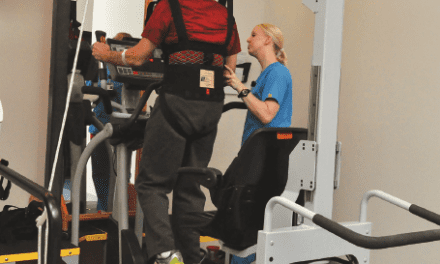Physical therapy clinic owners discuss electronic SOAP Notes and the impact it has had on their clinics’ daily operations
By Cassandra Perez
Physical Therapy Products hosted a roundtable discussion with several physical therapy clinic owners on the topic of electronic SOAP Notes. Participants discussed the effect SOAP Notes software has had on their practice’s efficiency and speed of reimbursement, as well as the software features that have helped improve accuracy and completeness of their staff’s note-taking. In addition, the participants addressed questions about mobile technology, the measures they have taken to prepare for the future ICD-10 transition, and how electronic SOAP Notes have supported their compliance needs.
The participants for this roundtable discussion include: John Gallucci, Jr, MS, ATC, PT, DPT, founder and president, JAG Physical Therapy; Christopher J. Morton, Sr, PT, DPT, CCCE, co-founder, Mariners Physical Therapy; Greg Todd, PT, OCS, CSCS, co-owner, Renewal Rehabilitation; Janis Kemper, PT, co-owner, Northern Physical Therapy; Daniel R. Brauning, MPT, MTC, ATC, co-owner and VP of clinical services, Ideal Physical Therapy; and Mary Rachford, PT, owner, Naperville Physical Therapy.
- Daniel R. Brauning, MPT, MTC, ATC
- Christopher J. Morton, Sr, PT, DPT, CCCE
- Greg Todd, PT, OCS, CSCS
- Janis Kemper, PT
- John Gallucci, Jr, MS, ATC, PT, DPT
- Mary Rachford, PT
Physical Therapy Products (PTP): What specific software features have improved the completeness and accuracy of clinicians’ note-taking in your practice?
John Gallucci, Jr, MS, ATC, PT, DPT: As we know, the entire medical profession has moved to electronic medical records (EMR). This has assisted in the fluency of being able to progress patients’ plans of care and better facilitate case managers and insurance companies with legible, accurate records, which has assisted in a more timely reimbursement process. JAG Physical Therapy uses a PT-based EMR system that is called WebPT, which has been outstanding for my corporation’s growth.
Christopher J. Morton, Sr, PT, DPT, CCCE: The ability to customize phrases and templates for typical diagnoses, including H and P, clinical tests, and measures. Our system, Clinicient, also allows dictation into the various fields, which allows more comprehensive notes with less repetition and less of a “canned note” appearance. Additionally, the previous note is carried forward to current treatment, allowing the therapist to review subjective complaints as well as to compare most recent clinical findings.
Greg Todd, PT, OCS, CSCS: I currently use PTOS, and the ability to customize our daily notes, progress notes, and our initial evaluations has allowed for improved ability to be accurate with our note-taking, and focused more on patient care. Also, the fact that our software scheduling is integrated with our note-taking has made it easier for our front desk and our physical therapists to communicate with one another regarding authorizations of visit, or prescription expirations. It helps our therapists know what type of note needs to be done for a particular visit.
Janis Kemper, PT: Our clinic currently uses software from Raintree Systems. The initial evaluations are very comprehensive. The evaluations are made to work well for many therapy settings. The really great time-saver for the initial evaluations are templates that we can make globally (for all therapists) and then specifically for each therapist. This saves a lot of time for them, as it sets it up just the way they like it and there is no limit on how many they can have. For example, some of our therapists have for the knee—a general knee, a geriatric knee, and an athletic knee. This sets the goals appropriately for each type of patient. The administration team is able to add all kinds of reminders or clues to help the therapists complete their notes and post their charges. And also charge optimally according to a specific payor’s guidelines. Progress notes, discharge notes, and daily notes are other helpful features.
Daniel R. Brauning MPT, MTC, ATC: We use TheraOffice as our EMR. The program is great and saves us a ton of time. They have standard evaluation templates set up, or you can create your own, which is a fantastic feature. Evals can be completed in less than 10 minutes, and a daily note can be done in less than 3 minutes. This is really important when you are trying to maintain a busy schedule. One great feature with the daily notes is that all of the previous notes, information automatically populates into the next note. You simply have to make adjustments based on the current day’s treatment. You can also set up treatment protocols or different groups of treatments/exercises. Again, this saves a ton of time.
Mary Rachford, PT: The warnings that certain codes cannot be billed for certain dx codes helps to avoid denials. The carryover of exercises from day to day reduces the time spent with documentation. TheraOffice’s Functional Vibe was great for downloading functional test scores directly into evaluations, saving time tabulating scores. Having the ability to customize evaluations is also a time-saver.
PTP: How have electronic SOAP Notes affected your staff’s note-taking time? Has it improved efficiency or allowed therapists to make notes in greater detail?
Gallucci: EMR has assisted with my physical therapists’ time management to more efficiently complete their notes on time with much better accuracy, which overall has improved our patient care by decreasing the note-writing time.
Morton: Significant improvement in productivity as well as detail in reporting. As clinical director, I can also monitor all other staff’s documentation for detail, charges, and timeliness.
Todd: Electronic SOAP Notes have been a huge advantage for our practice. It has improved our efficiency, and has allowed our therapists to take notes in greater detail. The software program that we use also allows it to be integrated into the billing, so we no longer feel as though we are doing additional steps. It also allows for our therapist to prepare for new patients that they haven’t seen, because exercise flowsheets and prior notes are available via electronic record-keeping, so they can review the patient chart remotely as well.
Kemper: The daily notes are fast and easy to complete. Because of the roll forward feature, you can easily tell what was done on the last visit. Also from a daily note, it is easy to progress the patient’s programs. Progress notes and discharge notes are very easy to tell the progress a patient has or has not made.
Brauning: Notes are faster, more accurate, and more detailed. I cannot imagine ever going back to a paper chart system. It would be horrible!
Rachford: Documentation time has been reduced significantly since switching over. Electronic notes are much easier to read, so sharing patients is not a problems as it had sometimes been in the past with PTs with sloppy handwriting.
PTP: Prompt submission of SOAP Notes can speed the billing process. What effect has your electronic SOAP Notes solution had on the speed of reimbursement?
Gallucci: As stated previously, the efficiency of EMR has reduced waiting time of reimbursement, which ultimately assists with revenue streams to maintain a viable, strong corporation.
Morton: Our documentation system is integrated with the billing system, so at the time the note is signed it is immediately billed electronically. The system is completely paperless, and our normal turnaround is typically less than 7 days. Notes can also be electronically faxed during note signing as well.
Todd: I really can’t say that it’s had a huge effect on our speed of billing. In our company, we bill twice a week, and we make sure that we have our SOAP notes attached to each of our plans that require notes to be attached. One of the neat things with regard to electronic documentation is that if I happen to not be at the clinic, I can remote into our server and finish any of the notes. It’s a secure way of doing it, and it allows me to handle my notes remotely. That has been a big asset for me.
Kemper: Wow, this part has been awesome! There are reports we can run regularly to make sure all of the notes are posted. Because our software for notes is the same as our billing program, the billers send out bills very quickly and according to payor guidelines. Our clearinghouse is very good at “talking back” to our software, which means our payments are coming in very quickly. Our average DSO has improved from 120 days to about 70 days.
Brauning: With our system, as soon as you close your note, the charges for the visit are instantly sent to billing. This makes the process of sending out claims significantly faster. The faster you send out claims, the faster you get reimbursed.
Rachford: The PTs must have the Daily Note locked and completed before they can see the patient for the next visit. I work closely with our business manager, and so I greatly appreciate the software’s “encouragement” to get the charges moved over to the accounting module so claims are billed quickly. Currently, I am getting claims back within 10 to 21 days. That helps with accurate payment turnaround from the patient, the final component of the reimbursement process.
PTP: How well are your electronic SOAP Notes supporting the compliance needs of your clinic (for example, G-code requirements for Medicare reimbursement)?
Gallucci: Our vendor has been on the cutting edge and stays ahead of all the new Medicare coding and ICD-10 transition. I can only comment on the program that we use, but we have been very happy with it.
Morton: All Medicare items are flagged if G codes, time codes, and KX modifiers are in conflict or incomplete. The system also has FLR reporting built and activates on the ninth visits, and will not let the therapist sign off until the required FLR is completed.
Todd: We recently moved to a new documentation system, and our electronic notes have been customized to have the G codes put in for Medicare reimbursement. It has made the process a lot easier for us. Because our SOAP notes are integrated with our scheduling system, we get notifications on when G codes are required to be put into the patient’s notes and claims. We have used the template system, to integrate the different functional codes in our progress notes and our initial evaluations.
Kemper: This is one of the best parts, and our vendor works very hard to make these requirements ready by the deadline. These work very well, and we can’t even post a note if we didn’t report things like G codes correctly.
Brauning: It has all the functional limitation reporting built into it. You cannot close the note until it is complete and done correctly, which is great for compliance. It also warns you on the 10th visit that it is due again and will not let you close that note until it is done. We all stressed out about FLR before we actually had to implement it, and that was all for nothing. It is actually really easy to be compliant.
Rachford: Our system has been very proactive in healthcare changes. I have yet to get worried about a deadline not being met. We have actually had the luxury of having a working process well in advance of any cutoff date imposed. Of course, sometimes those deadlines get pushed back, giving us even more time to adapt to the changes.
PTP: With the increasing popularity of handheld devices, how important do you feel it is to be able to document and access notes on mobile technology?
Gallucci: My personal belief is that when you’re with a patient, you should be focused on the patient. Although the utilization of iPads, iPods, tablets, and smartphones may be convenient, I feel it should never be utilized during patient care. Mobile technology in my practice has not truly made a huge change in the way we operate.
Morton: This is one of the weaker areas of EMR, in my mind. I have attempted touch screen computers and iPad-type solutions, but ultimately, it has been too difficult to provide detailed information in that format. Notes always appear “canned” and incomplete, and the therapists end up having to type into the report anyway.
Todd: For me, this is a big deal. I love to use a tablet while in the clinic. I use a lot of applications for anatomy to present to patients, and it’s nice that I can quickly transition from documenting, to educate patients via one of the mobile apps that I use. Being able to document from my iPad is a necessity for me, and the fact that the documentation system that I’m currently using has a native iPad format has made it very helpful for me. I use my iPad for 90% of my tasks while working in the clinic.
Kemper: This is a bit more difficult for me to answer. We work from laptops. I do think it is important to be able to use mobile technology, but we haven’t used them at this point.
Brauning: I think this is really important. We need to embrace technology because it makes our life easier. Paper flow sheets and things like that need to be a thing of the past. I love the fact that after a really busy day I can leave the clinic and go home to my wife and dog, sit on my couch, and finish my notes for the day!
Rachford: First, it depends on the therapist. Some are more tech-savvy than others, and they want the technology. Others who are older or who can’t type might not take to it as easily and resist. It comes down to the ease of use to create a document that is lock-tight for compliance. Second, ease of use might not be just from a software standpoint if the Wi-Fi capabilities or limitations of the office network are subpar. You could have a great user-friendly software that gets bogged down in the cloud and interrupts the note-taking efficiency. Screen size could also be an issue. Are we talking about using phones or tablets? The more screen landscape you have, the better. Do you lose that personal, caring feeling you provide the client if you look like, to them, that you are checking your Facebook account instead of doing their documentation?
PTP: What steps or measures have you taken to prepare your clinic’s software for the future transition to ICD-10?
Gallucci: I have been working consistently with my outsourced billing company and our EMR system to make sure that the systems communicate efficiently and our transition will be seamless.
Morton: We do not expect any significant disruptions with the ICD-10 conversion. Our EMR system has all the current ICD-9 codes, which can be cross referenced to code description as they convert to ICD-10. Our practice-management company makes all changes to their software updates on their system, and the changes update our system when we log into the system.
Todd: Truthfully, I personally haven’t taken any steps within my practice with regard to my clinic software for the future transition to ICD-10. I plan on speaking with the developers, and get their input on what things I need to do in order to prepare for that.
Kemper: I know that our vendor’s team has taken a lot of steps to prepare for this. Of course, we put this on the back burner for now, but I know that we prepared for this to happen.
Brauning: All of the ICD-10 codes have already been built into our system. It will be a seamless transition once we have to switch over. It really will not be a problem.
Rachford: Now that it has been pushed back (surprise, surprise), I’m waiting on our vendor to provide the update. Other than that, I will get myself geared up for it with training as it gets closer. We are a small four-PT clinic, and I do all the billing, so it will fall on me. The complexity level will be a challenge at first, but, as with any change, the more you work with it, the easier it becomes. PTP











